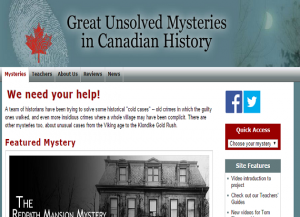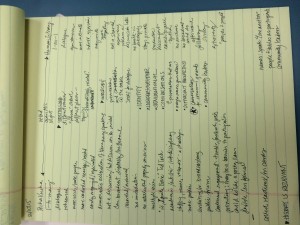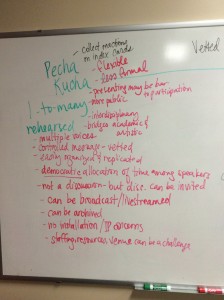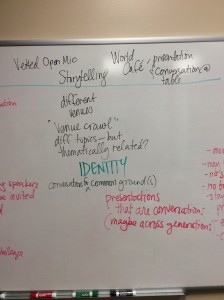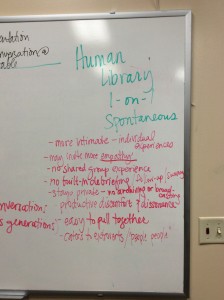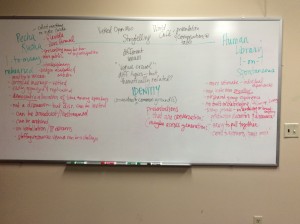Liu Bolin: Hiding in the City
I entered the museum with the intent to see how the art museum integrated participatory elements to its exhibits. I had not been to the art museum in years, so I was interested to see the changes that have occurred in the last 10 years. Surprisingly, despite the museum adding big screen TV’s; there was nothing particularly new or exciting in regards to a participatory museum. Using the chart on page 26 of The Participatory Museum, the gallery might reach stage two, since there are very few opportunities to participate with the content or with other museum visitors.
To the immediate left, as visitors enter the exhibit space, there is a small television that plays a four-minute animated cartoon describing social skills needed for museum etiquette. Even though the cartoon is cute, the television is in an awkward space – right in the way of traffic, and it is hard to stand there for the full film. It might be more appreciated and appropriate in the children’s section.
The first thing I noticed about Bolin’s work is that the pictures are hyper glossy. I spent about 3 seconds at each piece, sometimes straining to find the artist. (Bolin is painted in order to blend with his background.) A docent, Alize Norman, must be a regular face in the museum- there was a line of people milling around waiting to ask her questions. She was caring and kind to the visitors. The other docents, meanwhile, just walked around and looked too busy to help. My experience in the first room was pretty superficial; the artwork was neat, but I did not realize that there was a “message” to the art.
In the second room, the large picture of Cancer Village was the first sign that there was something deeper to the exhibit, that Bolin was more than a gimmick. In the corner of this second gallery is a screen that has interviews and a Ted Talk with the artist. The 7.5-minute Ted Talk is imperative to get the deep message of the artwork. It turns to the art from a really neat “Where’s Waldo” type game to a very meaningful and thoughtful experience. Unfortunately, the set-up is uncomfortable. The seats are low and the screen is too close for me to see comfortably, and the seat hard on the behind. Since it is in a dark corner, I kind of felt like I was in trouble. I would never have used this set- up if it weren’t for the class. Other people would stop and watch me watch the screen, but while I was in that gallery, no one else watched the films. It is a missed opportunity, for the films are so good. Maybe if the films were available to watch on a coffee-shop type countertop with high stools and laptops and headphones, the station would be more welcoming and popular.
The Boise Art Museum definitely is highly participatory in regards to its children’s program. In this, the museum achieves every step of social participation. It is also careful to ensure that each age level is given opportunity to interact with art. The Art Experience Gallery has solitary activities such as blocks and jigsaw puzzles to a highly participatory art class that is based on Bolin’s exhibit. The hands-on class was filled with 15 children and 10 adults who were busy sharing art supplies and encouragement. Also, at the entrance of the museum, Family Activity Packs are available for checkout. These packs include: a book on what to look for in museums, a list of things to search for in the museum, and drawing pads where children can draw a picture of their favorite things they see. This pack provides a great way for parents to interact with their children as well as the museum.
For adults and teens, the only digital opportunity to create comes from a set of computers that are located in a tucked away space. Here, there are three activities visitors can do to interact with the museum. The first activity is to create a new “label” for a piece of art displayed on the screen. I did not understand the purpose of this activity, since the art shown already had the official name of the piece, its description, etc. I could not see why anyone would want to create a new label, unless it was to be snarky. There are no example of anyone else who had done this activity, so I was not sure what the expectations were or where other visitor’s were going with the activity. The second activity is to create a postcard that would be e-mailed to the creator. The final option is to leave a comment about the user’s museum experience. I realize that there is a big push to integrate digital components into the museum, but the activities are shallow and the second activity, in particular, is confusing. The computers go against what Simon admonishes – digital and participatory elements need to have meaning, not just be fun or be there for the sake of being there.
Why is there such a discrepancy between the opportunities to participate between children and adults?
In the reading, I am concerned about the use of perks to increase the number of memberships. I understand that most museums are in a financially precarious situation and need to increase revenue, but how does this not go against the quest to democratize public history? Thoughts?
